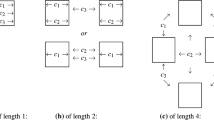Abstract
In this article, the groups acting on parallelisms in PG(3, q), q = pr, which are generated by collineations of order a p-primitive divisor of q3 − 1 are completely determined. In particular, when the group generated is non-solvable only the groups PSL(2,7) or A7 are possible. If the parallelism is transitive then either it is one of the two regular parallelisms in PG(3,2) or the group is solvable and is contained in гL(1,q3)/Z, where Z denotes the scalar group of order q − 1.
Similar content being viewed by others
References
J.H. Conway, R.T. Curtis, S.P. Norton, R.A. Parker, R.A. Wilson, The Atlas of finite groups, Clarendon, Oxford, 1985.
R.H.F. Denniston, Packings of PG(3,q) Finite Geometric Structures and their applications, (Bressanone, 1972), Cremonese, (1973), 195-199.
J.D. Dixon and B. Mortimer, Permutation groups, Springer-Verlag, New York, Berlin, Heidelberg, 1996.
D.A. Foulser, Baer p-elements in translation planes, J. Algebra. 86 (1974), 354–366.
M.J. Ganley, Baer involutions in semifields of even order, Geom. Ded. 2 (1973), 499–508.
W. Hartley, Determination of the ternary collineation groups whose coefficients lie in the GF(2n), Ann. Math. 27 (1926), 140–158.
B. Huppert, Endliche Gruppen I, Springer-Verlag, Berlin, Heidelberg, New York, 1979.
V. Jha and NX. Johnson, Coexistence of dations and large Baer groups in translation planes,. London Math, Soc. 32 (1985), 297–304
V. Jha and N.L. Johnson, Regular parallelisms from translation planes, Discr. Math. 59 (1986), 91–97.
NX. Johnson, Desarguesian partial parallelisms, J. Geom. (to appear).
NX. Johnson,Two-transitive parallelisms, Designs, Codes and Cryp. (to appear).
NX. Johnson and R. Pomareda, Construction of transitive partial parallelisms of deficiency one, (preprint).
W.M. Kantor and R.A. Liebler, The rank 3 permutation representations of the finite classical groups, Trans. Amer. Math. Soc. 271 (1982), 1–71.
G. Lunardon, On regular parallelisms in PG(3,q), Discr. Math. 51 (1984), 229–235.
H.H. Mitchell, Determination of the ordinary and modular ternary linear groups, Trans. Amer. Math. Soc. 12 (1911), 207–242.
B. Mwene, On the subgroups of PSL4(2m), J. Algebra 41 (1976), 79–107.
B. Mwene, On some subgroups of PSL(4,q), q odd., Geom. Dedicata 12 (1982), 189–199.
T. Penttila and B. Williams, Regular packings in PG(3,q), European J. Comb. 19 (1998), 713–720.
A. Prince, The cyclic parallelisms of PG(3,5), European J. Comb. 19 (1998), 613–616.
M. Walker, Spreads covered by derivable partial spreads, J. Comb. Theory (Ser.A) 38 (1985), 113–130.
Author information
Authors and Affiliations
Corresponding author
Rights and permissions
About this article
Cite this article
Biliotti, M., Jha, V. & Johnson, N.L. Transitive Parallelisms. Results. Math. 37, 308–314 (2000). https://doi.org/10.1007/BF03322000
Received:
Published:
Issue Date:
DOI: https://doi.org/10.1007/BF03322000



